Project Goal and Key Links
The goal of Project Tusk is to refit a vintage US Navy flight helmet to be stream-ready for combat flight simulation.
Project Tusk is designed to be compatible with Project Nimitz.
PROJECT TUSK IS CURRENTLY IN PHASE 4 OF 4.
See the Latest Video: The latest Tusk proof of concept video is embedded below.
For all Tusk videos, see the Project Tusk playlist on YouTube.
Stream It: Charles flies as callsign “Rocky” on Twitch stream “TheFlightSimGuy”.
Project Build Phases
The project will be built out starting from the original received artifact, in four phases, focused on different input and output components:
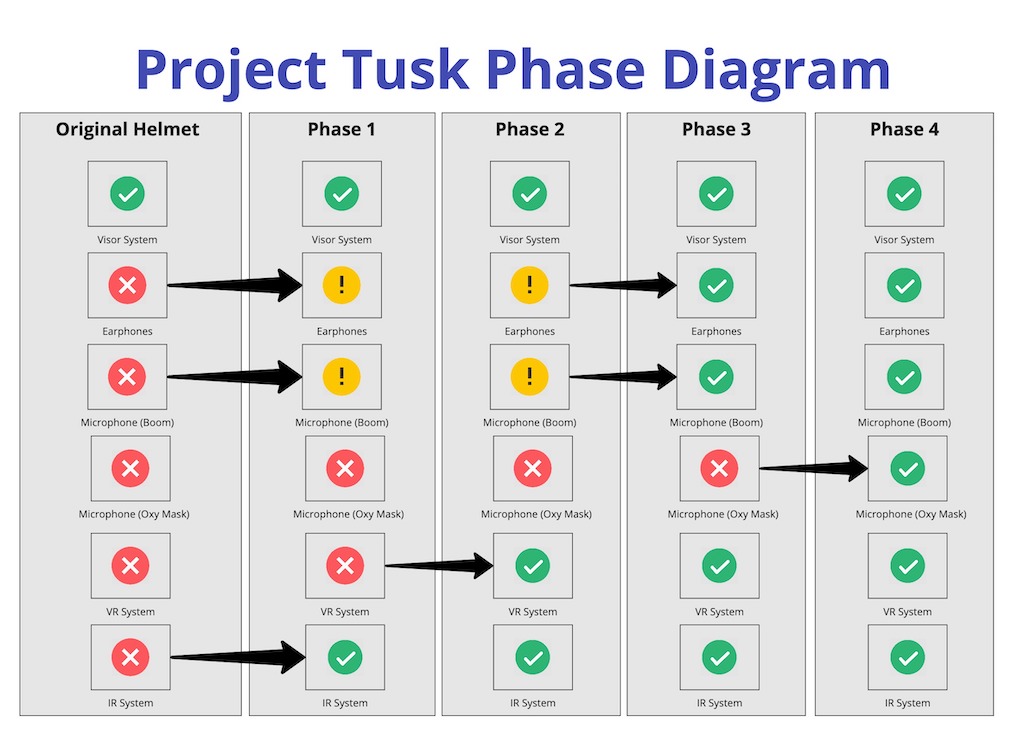 (Click for hi-res diagram)
(Click for hi-res diagram)
Read more about the phases below - as new phases are spun up you’ll see new sections below.
The Helmet Itself - a Historical Artifact
Tusk was just an idea until I found a helmet. Fortunately - this helmet found me: from my team of Future Leaders at the Museum of Flight, I received this legendary piece of US Navy history:
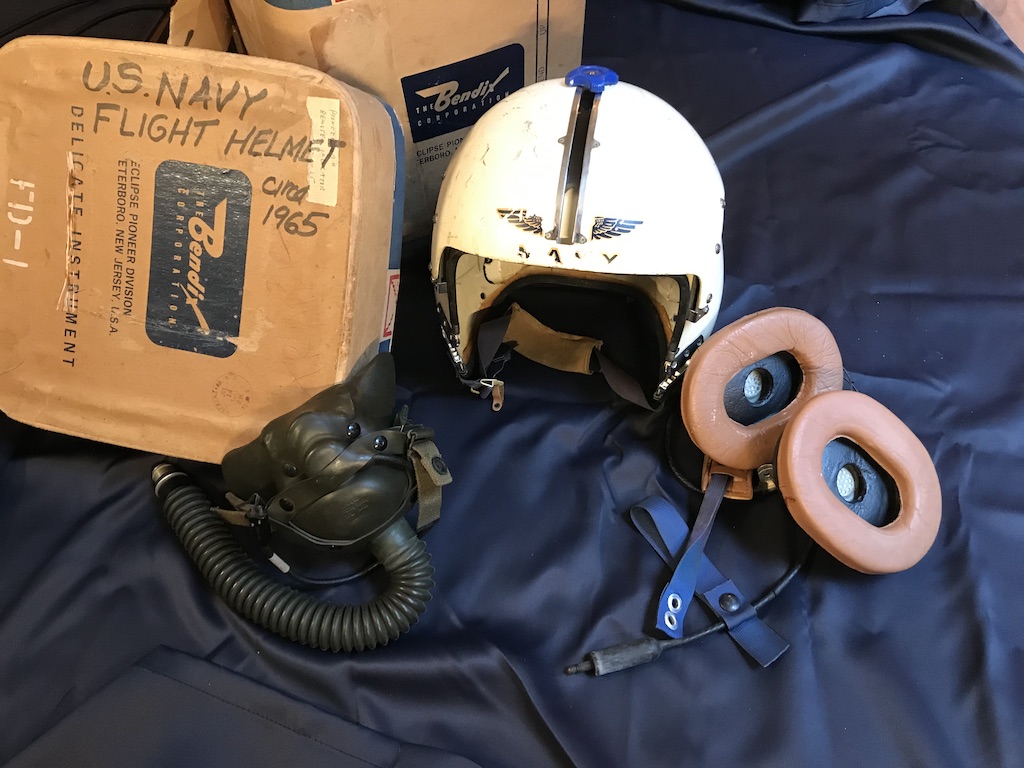
This helmet and accessories come from Charles W. Olson Sr., a naval aviator, and later an engineer with the Naval Air Development Center. Charles Olson passed away on July 18, 2019.
An APH-6A helmet, large size, manufactured by the Sierra Corporation, this artifact came with earpiece cups, an oxygen mask, and a working visor.
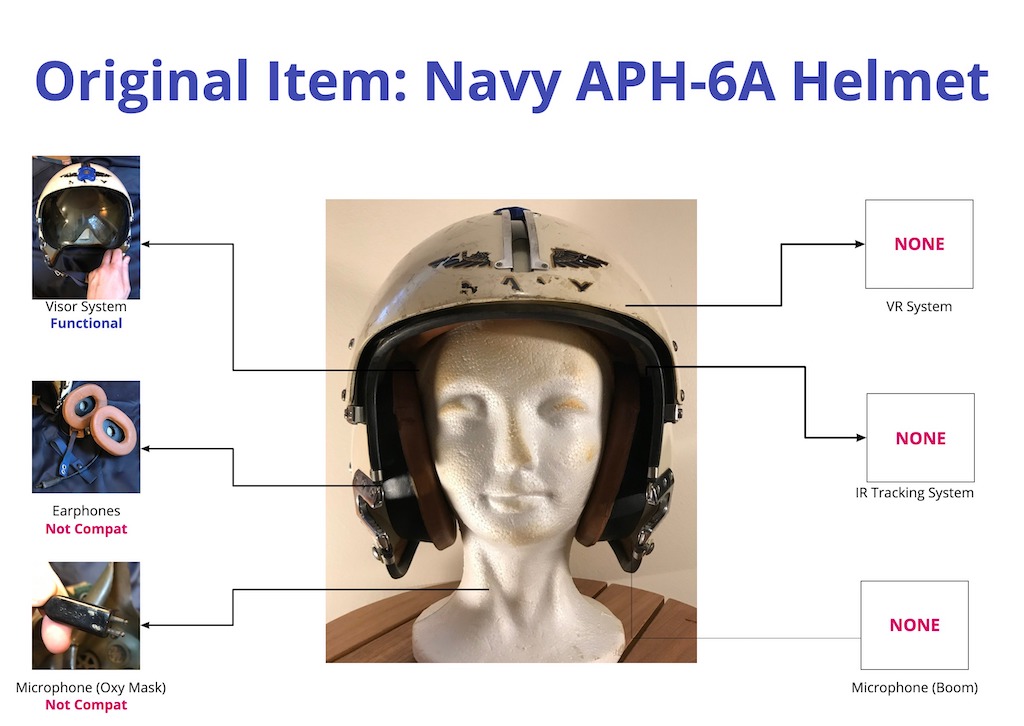
The helmet fits comfortably and is in good condition.
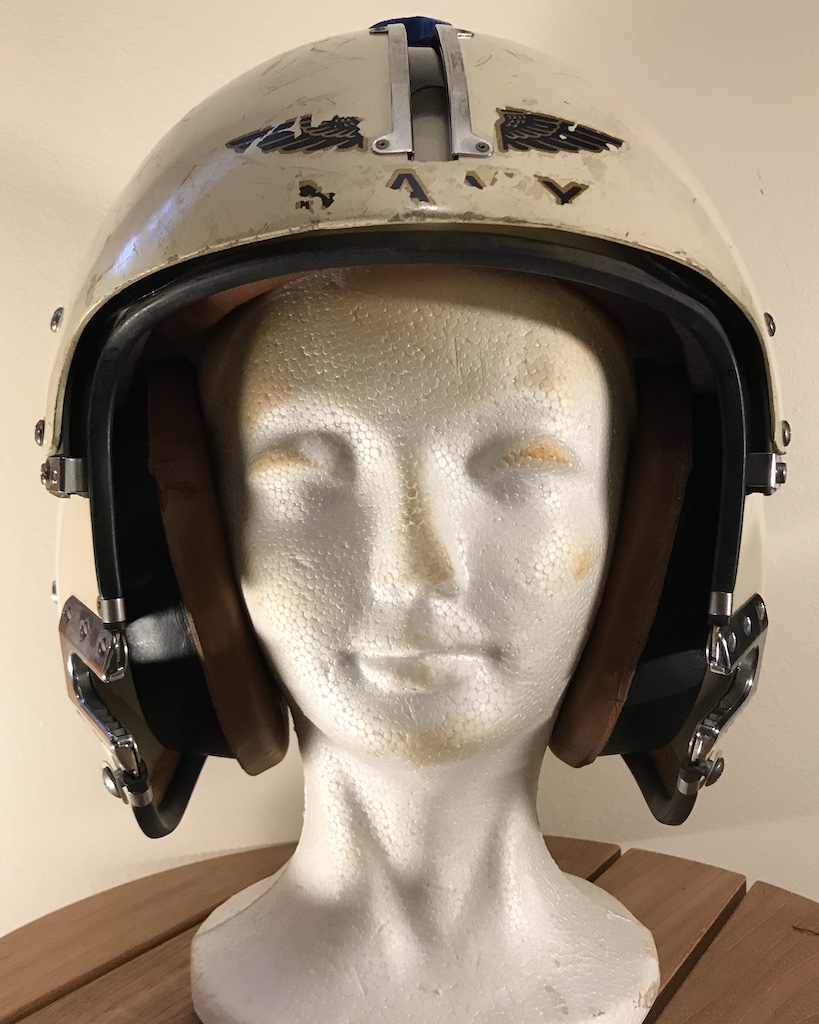
The audio earcups are comfortable and in good condition.
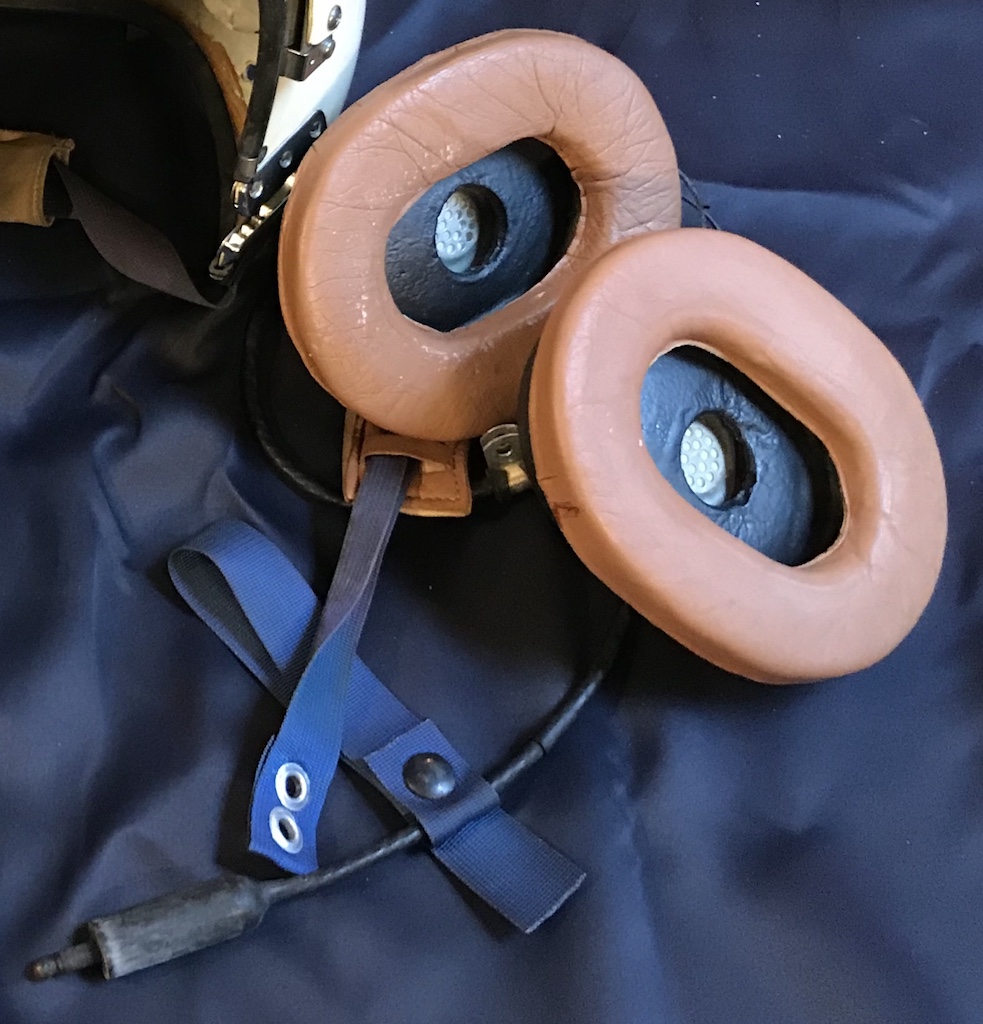
The visor, with the exception of a small chip at the bottom, is functional and in good condition.

From this excellent starting point, we move into Phase 1: wiring for sound and adding IR tracking.
Phase 1: Temporary Audio and Infrared Tracking
Phase 1’s goal is to gain the quickest path to Audio and Infrared Tracking. We will eventually wire up the helmet audio cups and use a real boom microphone, but to gain the fastest path to audio, we’ll substitute in a temporary headset and microphone.
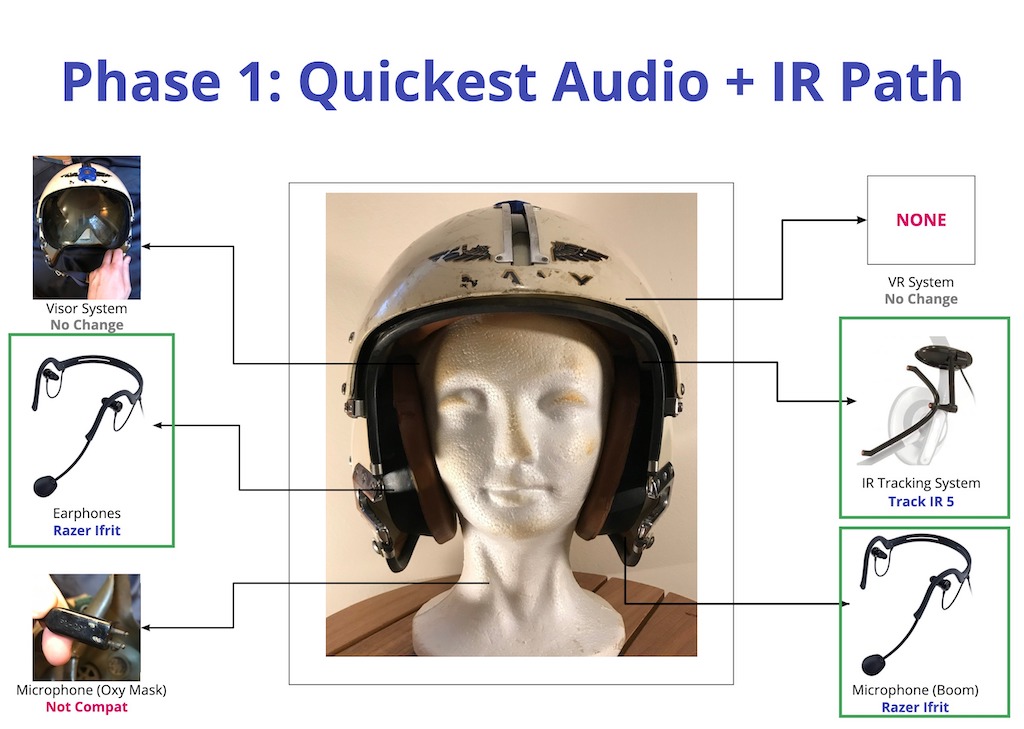
Break it down, build it up
The following components were changed or removed:
 The oxygen mask has an incompatible audio jack. The mask is temporarily removed; it will return in Phase 4.
The oxygen mask has an incompatible audio jack. The mask is temporarily removed; it will return in Phase 4.
 The audio cups were wired with an incompatible audio jack; wires were removed and the cups were reinstalled in the helmet.
The audio cups were wired with an incompatible audio jack; wires were removed and the cups were reinstalled in the helmet.
New items installed
- A Razer Ifrit low-profile wraparound headset + mic was added; the cups sit over the headset.
- A TrackIR5 system was velcro-attached to the left side of the helmet for IR tracking.
Challenges
- There was a screw missing for the audio cups. It was a 12/24”, a rare variant. A 5mm metric screw was used instead.
- The audio cups plus Razer Ifrit lead to a very tight helmet fit. The cup spaces are styrofoam, so they have very little “give” for fit.
- The boom microphone was a very sensitive condenser-type microphone, very dissimilar to traditional aviation microphones. The boom has to sit far from the face to avoid clipping.
- The IR tracker head mount center point was signficantly higher and to the left due to helmet shape. This makes certain angles more difficult to attain without losing IR signal.
Videos
Phase 2: Virtual Reality Headset Support
ON HOLD - Moving to Phsae 3
Phase 3: Integrated Helmet Audio
Phase 3’s goal is to make Phase 1’s audio system - a secondary headset under the helmet - completely unnecessary, by installing real audio hardware right into the helmet.

Break it down, build it up
The following components were changed or removed:
- The original H-87B earphones were removed from the ear cups.
- The Razer Ifrit low-profile wraparound headset + mic added in Phase 1 was removed.
New items installed
- A Vogek 20kHz headset with attached microphone was broken down into components - the drivers and microphone were installed in the helmet.
- Wiring was run across the back of the helmet, the microphone and 3.5mm jack extend out of the helmet out of the left hand side for connection.
Learn More About Phase 3
Read more about it in the Phase 3 blog post, or check out the video below!
Videos
Phase 4: Integrated Oxygen Mask Audio
Phase 4’s goal is to finish out the complete audio subsystem of the helmet, allowing microphone usage both with the oxygen mask and without, at high fidelity.
Swap in, swap out
The following components were changed or removed:
- The Vogek 20kHz headset which was only taped into the helmet in Phase 3, is glued into place and made final.
- The original MC-254-A microphone unit inside the helmet’s oxygen mask was removed.
New items installed
- A boom microphone mount and knurl knob was attached to the left side of the helmet. A lavalier microphone was threaded onto it.
- A lavalier microphone was threaded into the oxygen mask where the original MC-254-A microphone used to be.
- A set of straps were installed on both sides of the mask, with magnets attached at the ends. Similar magnets were attached on the helmet inside fittings, to allow the oxygen mask to quickly attach and detach.
Learn More About Phase 4
Read more about it in the Phase 4 blog post, or check out the video below!
Videos
